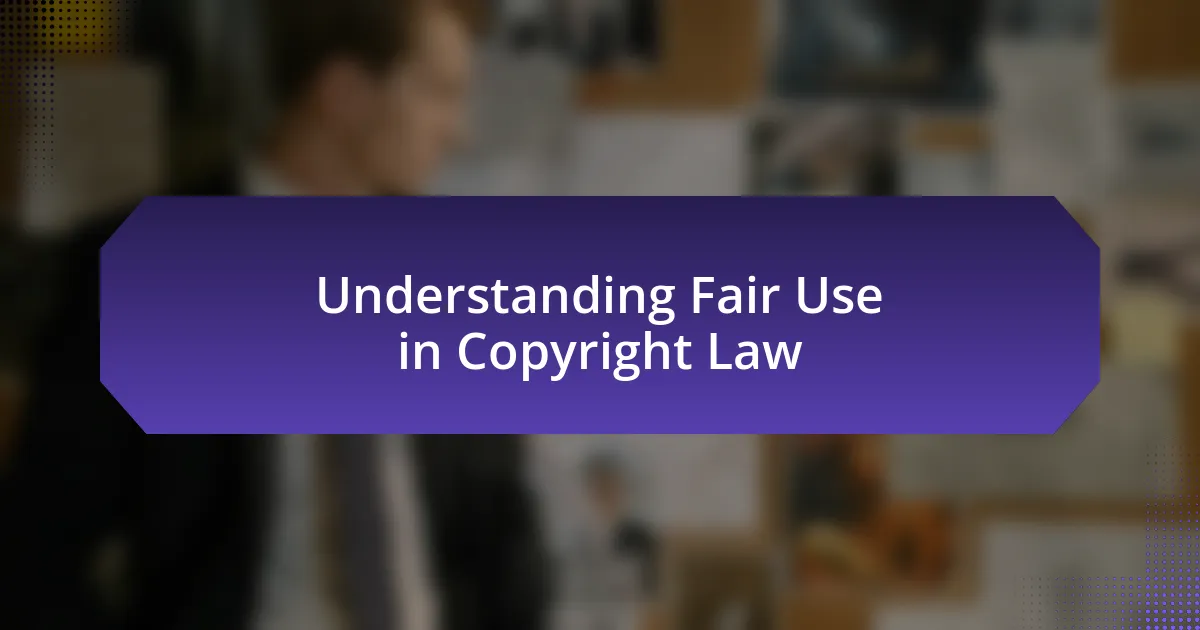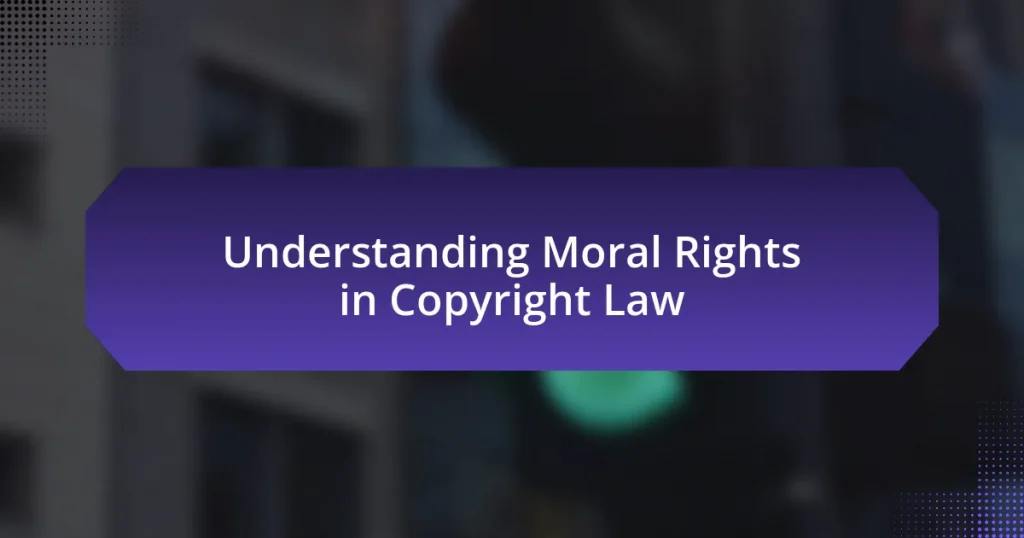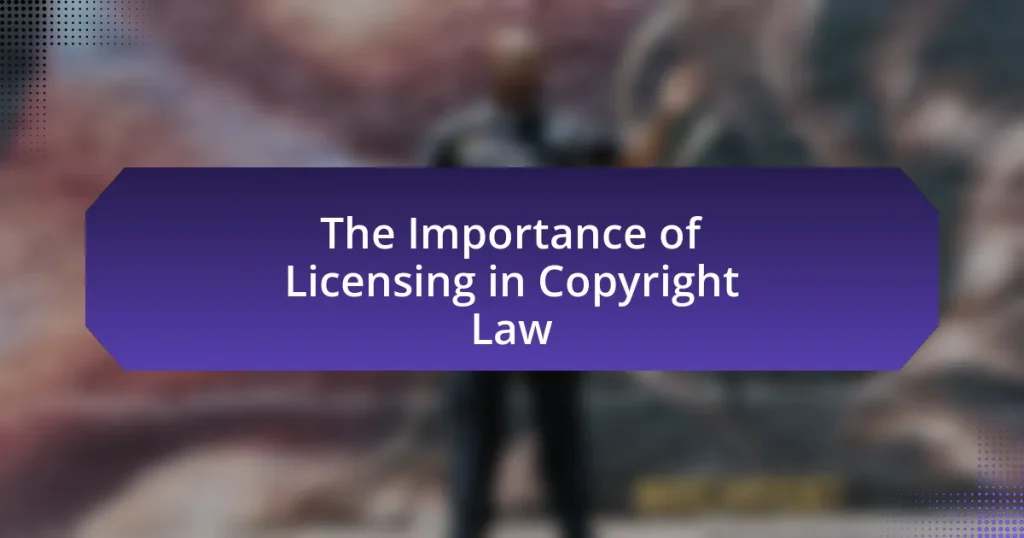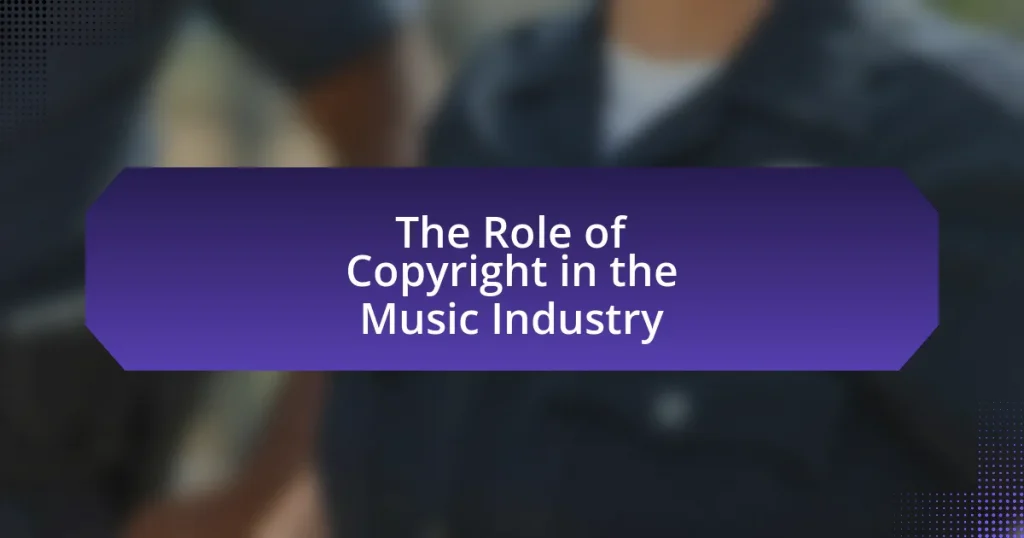Fair Use in copyright law is a legal doctrine that permits limited use of copyrighted material without permission from the rights holder, primarily defined by four factors: purpose and character of the use, nature of the copyrighted work, amount and substantiality of the portion used, and the effect on the market for the original work. This article explores the legal definition of Fair Use, its key elements, and its significance in creative industries, emphasizing its role in promoting innovation and access to information. It also addresses common misconceptions, the implications of using material without permission, and best practices for navigating Fair Use, providing a comprehensive understanding of this essential aspect of copyright law.
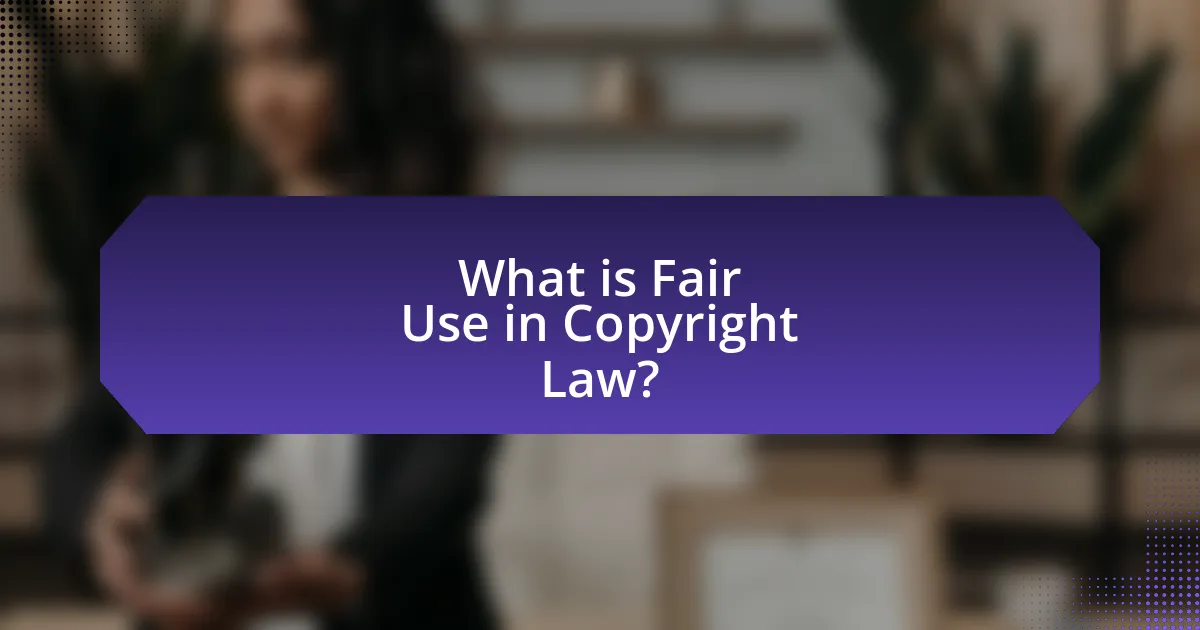
What is Fair Use in Copyright Law?
Fair Use in copyright law is a legal doctrine that allows limited use of copyrighted material without obtaining permission from the rights holder. This doctrine is primarily defined by four factors: the purpose and character of the use, the nature of the copyrighted work, the amount and substantiality of the portion used, and the effect of the use on the market for the original work. Fair Use is often applied in contexts such as criticism, comment, news reporting, teaching, scholarship, or research, allowing for a balance between the rights of creators and the public interest in accessing information.
How is Fair Use defined in legal terms?
Fair Use is defined in legal terms as a doctrine that allows limited use of copyrighted material without obtaining permission from the rights holder. This doctrine is codified in Section 107 of the U.S. Copyright Act of 1976, which outlines four factors to consider when determining whether a use qualifies as fair: the purpose and character of the use, the nature of the copyrighted work, the amount and substantiality of the portion used, and the effect of the use on the market for the original work. Courts have applied these factors in various cases, establishing precedents that guide the interpretation of Fair Use in copyright law.
What are the key elements that determine Fair Use?
The key elements that determine Fair Use are the purpose and character of the use, the nature of the copyrighted work, the amount and substantiality of the portion used, and the effect of the use on the market for the original work. These four factors are outlined in Section 107 of the U.S. Copyright Act. The purpose and character of the use assess whether the use is commercial or educational, with transformative uses more likely to be considered fair. The nature of the copyrighted work considers whether the work is factual or creative, with factual works receiving more leeway. The amount and substantiality factor evaluates how much of the original work is used, with smaller portions generally favoring fair use. Lastly, the effect on the market examines whether the new use negatively impacts the market for the original work, with a significant negative effect likely weighing against fair use.
How does Fair Use differ from other copyright exceptions?
Fair Use differs from other copyright exceptions in that it is a flexible doctrine allowing limited use of copyrighted material without permission, based on specific factors, rather than a fixed rule. Unlike other exceptions, such as the first sale doctrine or specific exemptions for educational use, Fair Use requires a case-by-case analysis considering factors like purpose, nature, amount, and effect on the market. This adaptability allows for a broader range of uses, such as criticism, comment, news reporting, teaching, scholarship, or research, which are not strictly defined in other exceptions. The U.S. Copyright Act of 1976 codified Fair Use, emphasizing its unique role in balancing the rights of copyright holders with the public interest.
Why is Fair Use important in creative industries?
Fair Use is important in creative industries because it allows creators to use copyrighted material without permission under certain conditions, fostering innovation and creativity. This legal doctrine enables artists, educators, and researchers to build upon existing works, critique, comment, or transform them, which is essential for cultural and intellectual growth. For instance, the U.S. Supreme Court case Campbell v. Acuff-Rose Music, Inc. established that parody can qualify as Fair Use, highlighting its role in promoting artistic expression. By balancing the rights of copyright holders with the public interest, Fair Use supports a dynamic creative ecosystem that encourages new ideas and diverse voices.
What role does Fair Use play in promoting creativity?
Fair Use plays a crucial role in promoting creativity by allowing individuals to use copyrighted material without permission under certain conditions, thereby fostering innovation and artistic expression. This legal doctrine enables creators to draw inspiration from existing works, remix content, and critique or comment on original pieces, which can lead to new forms of art, literature, and media. For instance, the U.S. Supreme Court case Campbell v. Acuff-Rose Music, Inc. established that transformative use, such as parody, qualifies for Fair Use, highlighting its importance in encouraging creative reinterpretation. By providing a framework that balances the rights of original creators with the need for cultural advancement, Fair Use supports a dynamic creative landscape.
How does Fair Use impact the distribution of knowledge?
Fair Use significantly enhances the distribution of knowledge by allowing limited use of copyrighted material without permission, thereby facilitating access to information. This legal doctrine enables educators, researchers, and creators to utilize existing works for purposes such as criticism, comment, news reporting, teaching, scholarship, or research, which promotes the dissemination of ideas and information. For instance, the U.S. Copyright Office outlines that Fair Use supports transformative uses that contribute to public discourse, thereby enriching the collective knowledge base. By reducing barriers to access, Fair Use fosters innovation and creativity, allowing new works to build upon existing knowledge while respecting the rights of original creators.

What are the Four Factors of Fair Use?
The Four Factors of Fair Use are: the purpose and character of the use, the nature of the copyrighted work, the amount and substantiality of the portion used, and the effect of the use on the market for the original work. These factors are used to determine whether a specific use of copyrighted material qualifies as fair use under U.S. copyright law. The first factor considers whether the use is for commercial or educational purposes, with educational uses often favored. The second factor examines whether the work is factual or creative, with factual works generally receiving more leeway. The third factor looks at how much of the work is used, with smaller portions typically being more acceptable. The fourth factor assesses whether the new use negatively impacts the market for the original work, with a negative impact likely weighing against fair use.
How does the purpose and character of use affect Fair Use?
The purpose and character of use significantly affect Fair Use by determining whether the use is transformative or commercial. Transformative uses, which add new expression or meaning to the original work, are more likely to be considered fair, as established in the case of Campbell v. Acuff-Rose Music, Inc. (1994), where the Supreme Court ruled that parody can qualify as fair use. Conversely, commercial uses that do not transform the original work are less likely to be deemed fair, as they may compete with the original work’s market. Thus, the evaluation of purpose and character is crucial in assessing Fair Use claims.
What constitutes transformative use in Fair Use analysis?
Transformative use in Fair Use analysis refers to the use of a copyrighted work in a way that adds new expression, meaning, or message, thereby altering the original work’s purpose. Courts assess transformative use by examining whether the new work provides a different insight or perspective compared to the original, which can include parody, commentary, or criticism. For example, in the case of Campbell v. Acuff-Rose Music, the Supreme Court ruled that 2 Live Crew’s parody of Roy Orbison’s “Oh, Pretty Woman” was transformative because it added new expression and meaning, thus qualifying for Fair Use.
How does commercial vs. non-commercial use influence Fair Use?
Commercial use typically weighs against a finding of Fair Use, while non-commercial use tends to favor it. The rationale is that commercial use often seeks to profit from the copyrighted material, which can harm the market for the original work. For instance, in the case of Campbell v. Acuff-Rose Music, Inc. (1994), the Supreme Court emphasized that commercial intent is a significant factor in determining Fair Use, as it can indicate a potential market impact. Conversely, non-commercial use, such as educational or personal use, is generally viewed more favorably under Fair Use guidelines, as it is less likely to compete with the original work or diminish its value.
What is the significance of the nature of the copyrighted work?
The significance of the nature of the copyrighted work lies in its influence on fair use determinations. Courts assess whether the work is factual or creative; factual works are more likely to be considered fair use compared to creative works. For instance, in the case of Campbell v. Acuff-Rose Music, the U.S. Supreme Court emphasized that transformative uses of creative works may still qualify for fair use, highlighting the importance of the work’s nature in legal evaluations. This distinction helps balance the rights of creators with public interests in accessing information and culture.
How does the type of work (factual vs. creative) affect Fair Use?
The type of work significantly affects Fair Use, with factual works generally receiving broader protection than creative works. Factual works, such as news articles or scientific reports, are more likely to be considered fair use because they contribute to public knowledge and discourse. In contrast, creative works, like music, literature, and art, are afforded greater protection under copyright law, making it more challenging to claim fair use when using these types of works. This distinction is supported by legal precedents, such as the case of Campbell v. Acuff-Rose Music, Inc., where the U.S. Supreme Court emphasized that the transformative nature of the use and the purpose of the work are critical factors in determining fair use, particularly highlighting the difference in treatment between factual and creative works.
Why does the availability of the work matter in Fair Use cases?
The availability of the work matters in Fair Use cases because it influences the assessment of whether the use is transformative and whether it affects the market for the original work. Courts consider if the work is readily accessible to the public; if it is, the likelihood of market harm increases, which can weigh against a finding of fair use. For instance, if a work is commercially available, using it without permission may undermine the original creator’s ability to profit, thus impacting the fair use analysis. This principle is supported by cases such as Harper & Row v. Nation Enterprises, where the Supreme Court emphasized the importance of market impact in determining fair use.
How does the amount and substantiality of the portion used impact Fair Use?
The amount and substantiality of the portion used significantly impact Fair Use by determining whether the use is permissible under copyright law. Specifically, using a small, non-central portion of a work is more likely to be considered fair use, while using a large or essential part may weigh against fair use. Courts assess both the quantity and quality of the material used; for instance, using a few sentences from a lengthy text may be acceptable, whereas using the main theme or a substantial excerpt could infringe on the original creator’s rights. This principle is supported by case law, such as the Supreme Court’s decision in Campbell v. Acuff-Rose Music, Inc., which emphasized that the heart of the work is a critical factor in evaluating fair use.
What is considered a “reasonable” amount to use under Fair Use?
A “reasonable” amount to use under Fair Use typically refers to a small portion of a work, often quantified as less than 10% of the total content. The determination of what is reasonable also considers the purpose of use, such as whether it is for educational, commentary, or transformative purposes. Courts evaluate the amount used in relation to the entire work, emphasizing that using a small, non-central part of a work is more likely to be deemed fair. For instance, quoting a few lines from a book or a short clip from a film for critique or analysis is generally acceptable, while using a significant portion of the work may not be.
How does the qualitative value of the portion used affect Fair Use?
The qualitative value of the portion used significantly affects Fair Use by determining whether the use is transformative or serves a different purpose than the original work. When a portion of a copyrighted work is used in a way that adds new expression, meaning, or message, it is more likely to be considered Fair Use. For instance, using a small excerpt from a book for commentary or criticism is often viewed favorably because it serves a different purpose than the original work. Conversely, using a highly creative or expressive portion, such as a key scene from a film, may weigh against Fair Use, as it could be seen as taking the heart of the work. Courts assess this qualitative aspect to evaluate the overall impact on the original work’s market value and the intent behind the use, which can influence the Fair Use determination.
What are the effects of the use on the market for the original work?
The use of a work under fair use can negatively impact the market for the original work by reducing its potential sales and licensing opportunities. When a derivative work or transformative use is created, it may serve as a substitute for the original, leading to decreased demand. For example, studies have shown that unauthorized reproductions can lead to a significant decline in revenue for original creators, as seen in the music industry where streaming services and cover songs have altered traditional sales patterns. This market effect is a critical consideration in fair use determinations, as the law aims to balance the interests of creators with public access to information and culture.
How do courts assess market impact in Fair Use cases?
Courts assess market impact in Fair Use cases by evaluating whether the use of copyrighted material adversely affects the market for the original work. This assessment involves analyzing factors such as the purpose of the use, the nature of the copyrighted work, the amount used, and the effect on the market value. For instance, in the case of Campbell v. Acuff-Rose Music, Inc., the Supreme Court emphasized that a transformative use that does not harm the market for the original work can qualify as Fair Use. This illustrates that courts consider both the economic impact and the qualitative aspects of the use when determining Fair Use.
What are examples of market harm in Fair Use disputes?
Market harm in Fair Use disputes can manifest in several ways, including loss of revenue for the original creator, diminished market value of the original work, and the creation of market substitutes that compete with the original. For instance, if a teacher reproduces a textbook chapter for a class without permission, the publisher may experience reduced sales, demonstrating direct financial harm. Additionally, if a film uses a copyrighted song without authorization, it may lead to a decline in music sales or licensing opportunities for the original artist, indicating a broader impact on the market. Courts often assess these factors to determine whether the use qualifies as Fair Use, emphasizing the importance of market harm in the evaluation process.

What are common misconceptions about Fair Use?
Common misconceptions about Fair Use include the belief that it allows for unlimited use of copyrighted material, that it applies only to educational purposes, and that it is a blanket exemption from copyright law. Fair Use is actually a legal doctrine that permits limited use of copyrighted material without permission, but it is subject to specific criteria, including the purpose of use, the nature of the copyrighted work, the amount used, and the effect on the market value of the original work. For instance, the U.S. Copyright Office emphasizes that Fair Use is determined on a case-by-case basis, and not all educational uses qualify as Fair Use. Additionally, many assume that simply attributing the source makes the use fair, which is not necessarily true; attribution does not replace the need to evaluate the Fair Use factors.
Is Fair Use a blanket permission to use copyrighted material?
Fair Use is not a blanket permission to use copyrighted material. Instead, it is a legal doctrine that allows limited use of copyrighted works without permission from the copyright owner under specific circumstances. The determination of Fair Use is based on four factors: the purpose and character of the use, the nature of the copyrighted work, the amount and substantiality of the portion used, and the effect of the use on the market for the original work. Courts evaluate these factors on a case-by-case basis, meaning that not all uses qualify as Fair Use, and misuse can lead to legal consequences.
What are the risks of assuming Fair Use applies?
Assuming Fair Use applies carries significant legal risks, including potential copyright infringement claims. When individuals or organizations incorrectly assume that their use of copyrighted material qualifies as Fair Use, they may face lawsuits from copyright holders seeking damages. The four factors of Fair Use—purpose, nature, amount, and effect on the market—are subjective and can lead to unpredictable outcomes in court. For instance, a 2019 case involving the photographer Lynn Goldsmith and the late musician Prince highlighted how courts can rule against those who believed their use was fair, resulting in a $2.5 million judgment. Therefore, without a thorough analysis of these factors, the assumption of Fair Use can lead to costly legal consequences.
Can Fair Use be claimed without permission from the copyright owner?
Fair Use can be claimed without permission from the copyright owner. This legal doctrine allows for limited use of copyrighted material without obtaining permission, provided that the use meets certain criteria established by law. The four factors considered in determining Fair Use include the purpose and character of the use, the nature of the copyrighted work, the amount and substantiality of the portion used, and the effect of the use on the market for the original work. Courts have upheld Fair Use in various cases, such as the landmark case of Campbell v. Acuff-Rose Music, Inc., which affirmed that transformative use can qualify as Fair Use even without permission.
What are the legal implications of using material without permission?
Using material without permission can lead to legal consequences such as copyright infringement claims, which may result in monetary damages, injunctions, or statutory penalties. Copyright law protects original works, and unauthorized use violates the rights of the copyright holder. For instance, under the U.S. Copyright Act, a copyright owner can sue for damages that may include actual damages and profits made from the infringement, or statutory damages ranging from $750 to $30,000 per work infringed, and up to $150,000 for willful infringement. Additionally, the infringer may face legal fees and costs associated with the litigation.

How can individuals and organizations navigate Fair Use?
Individuals and organizations can navigate Fair Use by understanding its four key factors: purpose and character of the use, nature of the copyrighted work, amount and substantiality of the portion used, and the effect of the use on the market for the original work. These factors help determine whether a specific use qualifies as Fair Use under copyright law. For instance, transformative uses that add new expression or meaning are more likely to be considered Fair Use. Additionally, educational, non-profit, or research purposes often favor Fair Use, as established in cases like Campbell v. Acuff-Rose Music, Inc., where the Supreme Court emphasized the importance of transformative use. By carefully analyzing these factors and seeking legal advice when necessary, individuals and organizations can make informed decisions about their use of copyrighted materials.
What best practices should be followed when considering Fair Use?
When considering Fair Use, best practices include evaluating the purpose and character of the use, the nature of the copyrighted work, the amount used, and the effect on the market value of the original work. These four factors, established by the U.S. Copyright Act, guide users in determining whether their use qualifies as Fair Use. For instance, transformative uses that add new expression or meaning are more likely to be considered Fair Use. Additionally, using smaller portions of a work and ensuring that the use does not negatively impact the market for the original work strengthens the Fair Use argument. Following these guidelines helps mitigate the risk of copyright infringement.
How can one assess whether a use qualifies as Fair Use?
To assess whether a use qualifies as Fair Use, one must evaluate four key factors established by copyright law: the purpose and character of the use, the nature of the copyrighted work, the amount and substantiality of the portion used, and the effect of the use on the market for the original work. The first factor considers whether the use is for commercial or educational purposes, with transformative uses more likely to qualify as Fair Use. The second factor examines whether the work is factual or creative, as factual works are more likely to be subject to Fair Use. The third factor looks at how much of the original work is used; using smaller portions typically favors Fair Use. Finally, the fourth factor assesses whether the new use negatively impacts the market for the original work, with a negative impact making Fair Use less likely. These factors are not rigid rules but guidelines that require a case-by-case analysis.
What resources are available for understanding Fair Use better?
The resources available for understanding Fair Use better include the “Fair Use Index,” which provides a comprehensive overview of court cases related to Fair Use, and the “Copyright Office’s Fair Use Guidelines,” which outlines the principles of Fair Use. Additionally, the “Stanford University Libraries Fair Use Checklist” offers a practical tool for evaluating Fair Use claims. These resources are validated by their use in academic and legal contexts, ensuring they are reliable for understanding the complexities of Fair Use in copyright law.
What steps can be taken to minimize legal risks associated with Fair Use?
To minimize legal risks associated with Fair Use, individuals and organizations should conduct a thorough analysis of the four factors that determine Fair Use: purpose and character of the use, nature of the copyrighted work, amount and substantiality of the portion used, and the effect of the use on the market for the original work. By carefully evaluating these factors, users can better assess whether their use qualifies as Fair Use. Additionally, obtaining permission from copyright holders when possible, documenting the rationale for Fair Use claims, and seeking legal advice can further reduce potential legal exposure. These steps are supported by legal precedents that emphasize the importance of a balanced approach to Fair Use assessments.
How can documentation and analysis support Fair Use claims?
Documentation and analysis can significantly support Fair Use claims by providing evidence that demonstrates the transformative nature of the use, the purpose and character of the work, and the amount used in relation to the whole work. For instance, thorough documentation of how a work is being used, such as educational purposes or commentary, can illustrate that the use is non-commercial and beneficial to the public, which are key factors in Fair Use considerations. Additionally, analyzing the specific portions of the original work utilized can show that only a small, necessary amount was taken, reinforcing the argument that the use does not negatively impact the market for the original work. Courts often rely on such documentation and analysis to assess Fair Use, as seen in cases like Campbell v. Acuff-Rose Music, Inc., where the Supreme Court emphasized the importance of transformative use and market impact in determining Fair Use eligibility.
What role does legal advice play in Fair Use decisions?
Legal advice plays a crucial role in Fair Use decisions by providing guidance on the interpretation and application of copyright law. Attorneys specializing in intellectual property assess the specific circumstances of a case, including the purpose, nature, amount, and effect of the use on the market value of the original work. This legal analysis helps individuals and organizations determine whether their intended use qualifies as Fair Use under the four-factor test established by the U.S. Supreme Court in the case of Campbell v. Acuff-Rose Music, Inc. (1994). Legal advice is essential for minimizing the risk of copyright infringement claims and ensuring compliance with legal standards.
